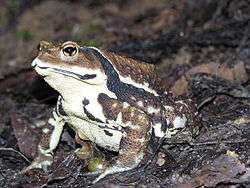蝦蟇
Chinese
| For pronunciation and definitions of 蝦蟇 – see 蛤蟆 (“frogs and toads”). (This term, 蝦蟇, is a variant form of 蛤蟆.) |
Japanese

蝦蟇 (gama, gamagaeru): a Japanese common toad.
Etymology 1
| Kanji in this term | |
|---|---|
| 蝦 | 蟇 |
| か > が Jinmeiyō |
ま Hyōgaiji |
| on’yomi | |
Appears to be borrowed from Middle Chinese 蝦蟇 (MC ɦˠa, “toad”, literally “shrimp, prawn + toad”).
Pronunciation
Alternative forms
Usage notes
As with many terms that name organisms, this term is often spelled in katakana, especially in biological contexts, as ガマ.
Synonyms
- 蟇蛙 (hikigaeru)
Etymology 2
| Kanji in this term | |
|---|---|
| 蝦 | 蟇 |
| Jinmeiyō | Hyōgaiji |
| Irregular | |
Appears to be a compound of 蟇 (gama, “toad”) + 蝦 (kaeru, “frog”). The kaeru changes to gaeru as an instance of rendaku (連濁). The kanji in this term are reversed as jukujikun (熟字訓) to match the Chinese spelling of the borrowed term gama (see above).
This article is issued from
Wiktionary.
The text is licensed under Creative
Commons - Attribution - Sharealike.
Additional terms may apply for the media files.